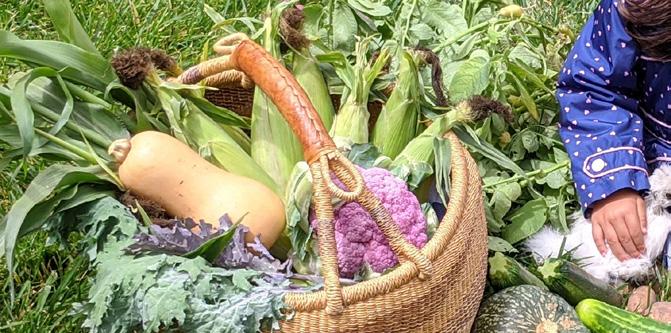
4 minute read
Starting a Fall Garden
A conversation with Vania Fusco, manager of the “Green Basket” Facebook group
Katie: Vania, I reached out to you because you manage the local Facebook group “Green Basket of Monterey,” and I know backyard gardening is something a lot of us are pursuing these days. Friends have mentioned wanting to get started but worry they’re jumping in too late; what would you tell them?
Advertisement
Vania: Many people think that spring was “high season” for growing vegetables and that their ship has sailed, but the next big season is just starting.
A fall and winter garden can be bountiful and easier to take care of than you think, as cooler weather helps retain moisture and keeps most of those pesky little pests at bay, two of the most significant issues for gardeners during the warmer months. Plus, with so many families keeping the kids at home during this school year, gardening provides an excellent platform for entertainment and relaxation. It offers a unique opportunity to learn about nature firsthand.
Katie: How do you choose what to plant?
Vania: The Monterey Peninsula as a whole is blessed with Mediterranean weather, and your specific location on the peninsula will determine what grows best. You’ll want to run a quick search of your hardiness zone by zip code (Monterey County is in USDA Hardiness Zones 8a, 8b, 9a, 9b, and 10a) the most suitable planting calendar for that specific area.
Top cool-season edibles include beans, peas, chard, broccoli, lettuce, carrots, cucumbers, kale, spinach, cabbage, tomatoes, cauliflower, squash, Brussel sprouts, and corn, among so many other enticing foods. There are so many tasty options that it may feel a little overwhelming, so to make things a little easier, I’ll share some quick tips to set you up for success.
Katie: Is there a way to avoid planting seeds–and then having to wait for them to grow?
Vania: One of the easiest ways to start your edible garden is by regrowing veggies. And a bonus — it’s free. You’re repurposing bits of food that you already purchased; why not put those to good use? Starting from seed takes longer, and different seeds have different needs. Regrowing is extremely simple. It’s halfway there already. Items you can easily regrow during the cool season include lettuce, radicchio, potatoes, sweet potatoes, onions, broccoli, garlic, beets, carrots, celery, and more. For the most part, you need to keep an inch or more of the heads or sprouts in fresh water for a few days before you transplant them into the soil. I suggest potatoes for first-time gardeners, as they are quite low mainte
nance, they produce generously, and they sprout in no time. Just place a few potatoes and an onion in a paper bag, leave it in a dark pantry space for a few days, and the potatoes will be full of sprouts that you can cut out and place straight in the soil.
Katie: If I don’t have much outdoor space is there anything I can actually grow indoors?
Vania: If you are willing to use a little of that indoor space, you’ll be amazed by the array of goodies you can grow yearround. I keep celery, basil, peppers, herbs, and tomatoes in our kitchen for a year-round bounty that uses just a few old yogurt containers in our window sill. You can also be an “herb ninja” and secretly hide small containers of herbs inside your larger planters around the house, or create some small “greenhouse” areas in your yard to allow you to grow items that do not particularly like the colder temps.
We moved to Pacific Grove a few years back and almost gave up on gardening until we learned that some of our favorite crops would grow here — like tomatoes if you choose smaller or early harvest varieties. One of our neighbors gifted us some Paul Robeson tomato plants, which not only stand the PG fog but also happen to be amazingly juicy and flavorful. This is the same neighbor who loves to say that he grows peppers in Pacific Grove. Indoors, that is.
Katie: Do I need to protect my garden when it gets colder?
Vania: If your neighborhood gets unusually chilly in the fall and winter, you can cover many veggies on a shoestring budget. For smaller vegetables, use an empty bottle or milk jug, cut the base and use it to protect your plant; for larger veggies, we use a tomato cage with a plastic bag over it. We also covered our raised beds with large poster frames we got from Last Chance Mercantile at just $0.25 each. They keep the soil warm and cozy, and it allows us to trim a bowl full of salad greens a few times a week.
Katie: What should a beginning gardener start with? Vania: Potatoes are perfect for beginners, along with gem lettuce, perpetual spinach, and green beans. My favorite vegetable to grow during the cool season is squash, especially kabocha squash. It is so amazingly flavorful, versatile and you can store it for a full year.
As we say in our group, share the bounty, and harvest happiness.
Katie: Thank you, Vania!
To look up your hardiness zone check: www.plantmaps.com
For planting schedules: www.ufseeds.com/learning/planting-schedules
For the Green Basket of Monterey: www.facebook.com/groups/352324522076936
Katie Raquel is the founder of Katie’s Coldpress, a Realtor with Over the Moon Realty and the author of SQUEEZED: The Raw Truth About Work-Life Balance. She lives with her family in Monterey County.








